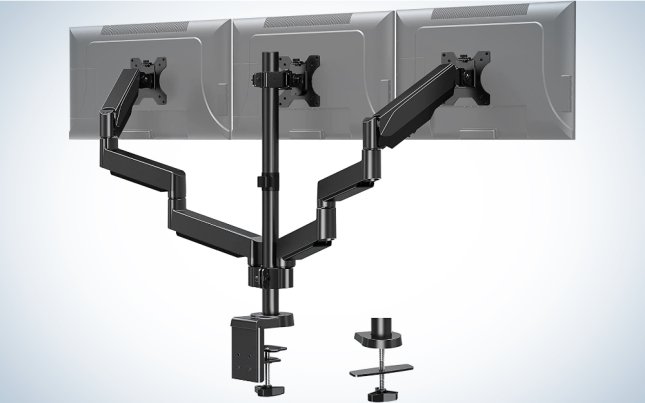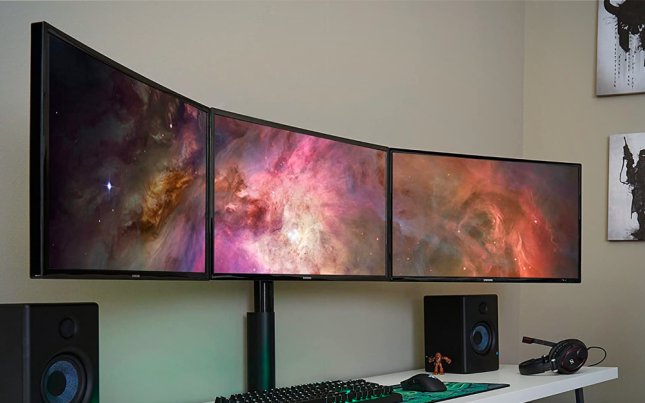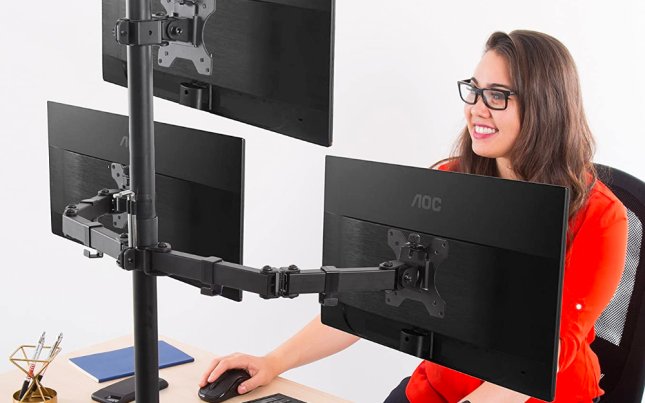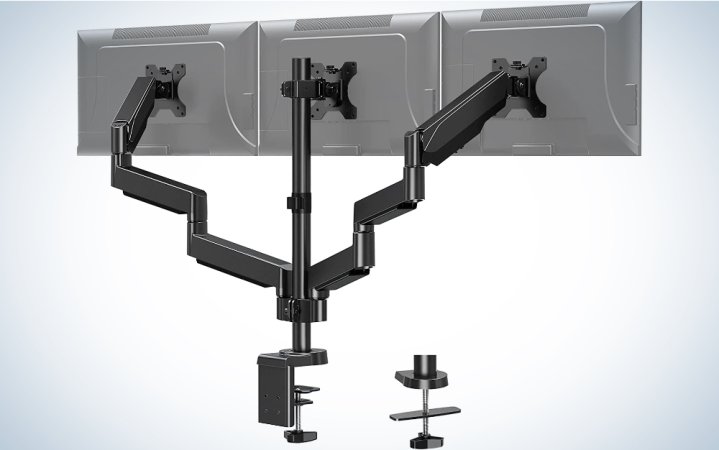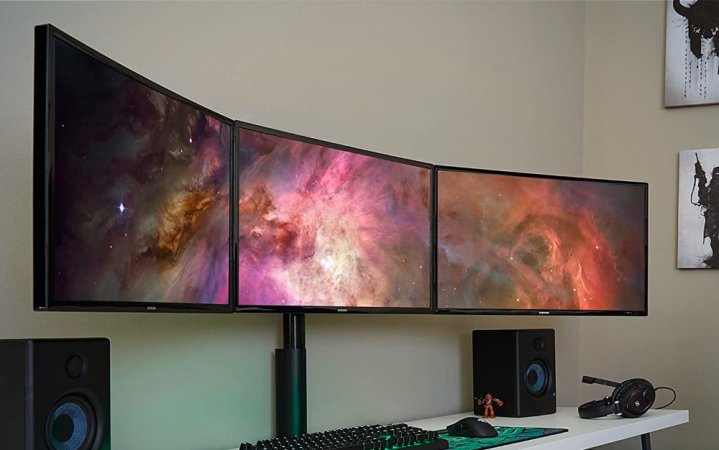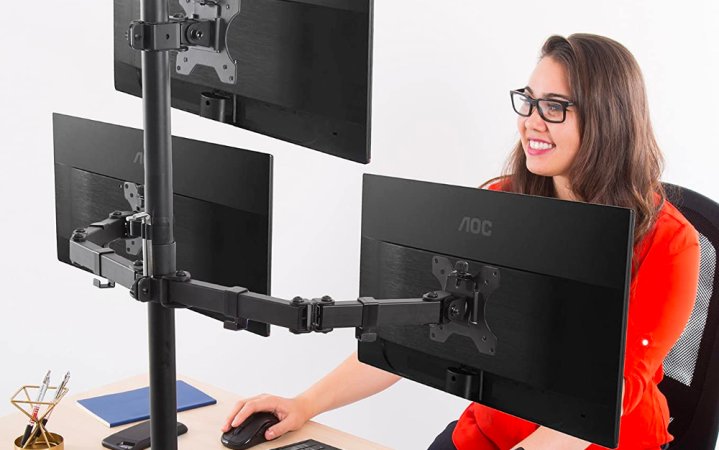We may earn revenue from the products available on this page and participate in affiliate programs. Learn more ›
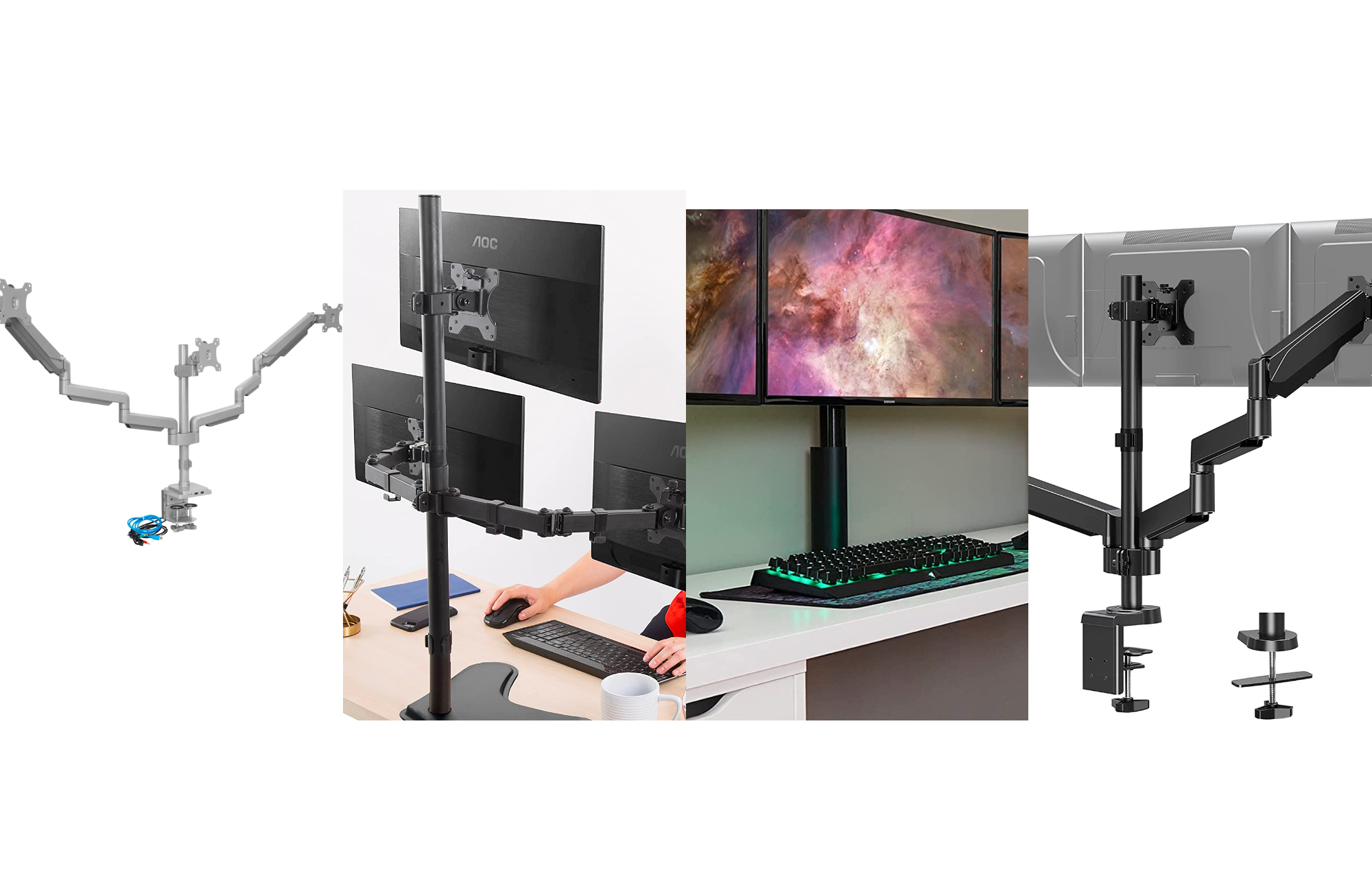
Few office accessories provide the kind of tech flex you get from a triple monitor stand. These adjustable arms can fill your entire field of vision with sweet screen real estate. Making the jump to three monitors is a serious move, but having one of the best triple-monitor stands to hold them up will make you feel like a Hollywood-style computer whiz (and there are actual real-world benefits, too).
- Best overall: Mount Pro Triple-Monitor Desk Mount
- Best side-by-side: Echogear Adjustable Triple-Monitor Desk Mount (ECHO-GM3C)
- Best pyramid-style: Stand Steady Freestanding Triple-Monitor Mount Desk Stand
- Best with USB Hub: Mount-It Triple-Monitor Mount with USB/Audio Ports
How we chose the best triple-monitor stands
To pick the best triple-monitor stands, I paired my own testing and experience with professional reviews and consumer feedback. We specifically looked at a wide range of triple-monitor stands that arrange your monitors in different orientations and prioritized those that gave users as much adjustability as possible. Unlike the best monitor arms and dual-monitor stands, there are no major tech peripheral manufacturers making triple-monitor arms right now. As such, we also prioritized popular arms with lots of positive reviews and recommendations from consumers.
The best triple-monitor arms: Reviews & Recommendations
So you have three monitors and you want to put them up on a single stand. Now that you know the basics of what to look for, we have a few recommendations, including arms that clamp to your desk and stands that stand free without any installation. You can set up your monitors side-by-side or stack them in a pyramid formation. Whether you’re looking to put a finishing touch on your office or enhance your gaming battle station, there should be a decent option for you among these picks.
Best overall: Mount Pro Triple-Monitor Desk Mount
Best overall
Flexibility For a Fair Price
Buy it used or refurbished: eBay
Why it made the cut: A fair price point and good feature set put the Mount Pro Triple at the front of the pack.
Specs
- Mount type: Desk-mounted
- Adjustment mechanism: Gas-spring and static height
- Weight range: 17.6 lbs per arm
- Display size range: Up to 27-inch
- Available colors: Black
- Price: $119
Pros
- Separate VESA plates for easy mounting
- Gas-spring movement means effortless adjustment
- Two mounting options: Desk clamp or grommet
Cons
- No depth adjustment for middle screen
The Mount Pro Triple-Monitor Desk Mount is an unassuming top pick: It’s simply solid in every way. Like many other mounts, it offers gas-spring movement for your left and right screens and adjustable height and rotation for your central screen. It supports a pretty high 17.6-pound upper weight limit, so it should be able to handle almost any 24- or 27-inch monitor. While it may annoy some that it doesn’t support larger displays, most users with multi-display setups normally stick to those sizes, anyway.
The only major flaw we found was universal across nearly every triple monitor mount we researched: the middle display offers monitor rotation, adjustable height, tilting, and swiveling, but not the ability to adjust its depth. If you have a particularly deep desk, you may want to go with our freestanding pick.
Best side-by-side: Echogear Adjustable triple-monitor desk mount (ECHO-GM3C)
Best side-by-side
Wider than an ultrawide
Buy it used or refurbished: eBay
Why it made the cut: Echogear’s triple-monitor stand stands out because of its unique form factor.
Specs
- Mount type: Desk-mounted
- Adjustment mechanism: Static height
- Weight range: 20 lbs per screen
- Display size range: Up to 27-inch
- Available colors: Black
- Price: $132
Pros
- Great for immersion
- Natural ergonomic curve
- US-based customer service
Cons
- Less adjustment than other options
- No grommet installation
Minnesota-based Echogear is known primarily for making wall mounts, but they make a very nice desk-mounted triple-monitor stand. It lines up the monitors, but arranges them in an ergonomic and immersive curve, turning your three monitors into a single, gigantic curved display array. It’s an appealing option for anyone who wants to set it and forget it, and could be great for hardcore racing or flight-sim players.
The curve also presents some limitations, though: For example, the mount isn’t really made to pair well with individual curved displays, even if they fit the size and weight limits. They also note that an older 27-inch monitor with a large bezel (the outer plastic frame), may cause some issues with fitting the screens.
Luckily, Echogear has excellent customer service. The company has chat and phone-based support options that typically answer quickly and accurately. If you aren’t sure if your monitors will fit in the display, customer service will help you figure things out before you buy.
Best pyramid-style: Stand Steady Freestanding Three-Monitor Mount Desk Stand
Best pyramid-style
Stable On The Table
Buy it used or refurbished: eBay
Why it made the cut: Stand Steady makes a really solid pyramid-style desktop triple-monitor stand.
Specs
- Mount type: Freestanding
- Adjustment mechanism: Static height
- Weight range: Up to 17.6 lbs
- Display size range: Up to 32-inch
- Available colors: Black
- Price: $99
Pros
- Freestanding mount can sit on any desk
- Supports 32-inch displays
- Pyramid configuration means less twisting your neck
- Separate VESA plates for easy mounting
Cons
- No depth adjustment for middle screen
Having three screens lined up side-by-side in landscape mode sounds like a great idea … right until you have a project where you’re constantly turning your from the left display to the right one. Without depth adjustment functionality or a natural curve, you’ll wind up twisting your neck a lot, which isn’t great for your body. A pyramid configuration—two monitors side by side at eye level, and a third dead center above the other two—is great if you use two displays often, and only glance at the third on occasion.
Stand Steady makes both freestanding and desk-mounted pyramid-style triple-monitor stands, but we went with the desktop option because it’s a little cheaper, and because it’s better suited to support three 32-inch displays.
Best with USB hub: Mount-It Triple-Monitor Mount with USB/Audio Ports
Best with USB Hub
Plug In and Declutter
Buy it used or refurbished: eBay
Why it made the cut: Honestly, we’re surprised more manufacturers haven’t built USB hubs into their monitor stands.
Specs
- Mount type: Desk-mounted
- Adjustment mechanism: Gas-spring and static height
- Weight range: Up to 15.4 lbs
- Display size range: 32″
- Available colors: Black
- Price: $147
Pros
- Separate VESA plates for easy mounting
- Gas-spring movement means effortless adjustment
- Two mount options: Desk clamp or grommet
- USB 3.0 and Audio jacks are a great bonus
Cons
- USB and audio jacks are pass-through, not hub
- Middle screen has no depth adjustment
- Low weight limit
The Mount-It Triple-Monitor Stand doesn’t do much that our other monitor stands can’t, but it has one surprisingly compelling ace up its sleeve: USB 3.0 and 3.5mm audio passthrough ports built into the base of the display. Unlike monitor USB ports, these are passthrough ports that need to be plugged into your PC using cables that come out the back of the stand. For most people, though, having those ports front and center is a big improvement on constantly reaching behind things or having external USB hubs taking up valuable desk real estate.
It also doesn’t feature a grommet-based mounting option, so you won’t be able to screw it into the back of your desk.
Things to consider before buying a triple-monitor stand
If you have three displays and are ready to upgrade to a triple-monitor stand or arm, there are a few important things to keep in mind. Monitor stands come in a few different form factors, which handle monitors differently and require varying amounts of installation. It’s important to know what you’re getting into before you start adjusting your workspace.
Desk clamps vs. stands: Triple-monitor stands can be mounted one of two ways: A freestanding monitor stand, similar to what comes with most monitors, or a desk-mounted stand that clamps to the back of a flat desk. Manufacturers also make dual- and single-monitor stands that bolt into the wall behind your desk, but there currently aren’t any wall-mounted triple-monitor options that we’re aware of at this time.
If you have a strong desk with a uniformly thick desktop, we prefer the desk-mounted route. It saves you a ton of desk space without sacrificing any sturdiness or durability. Not all desks can handle a desk mount, though. If you have a glass desk or one without a lip for a clamp to grip, stick to a freestanding mount. Seriously, a clamp could shatter a glass desk or fall right off an unsteady mount–taking all of your screens with it—so only consider this if you’ve invested in a sturdy option.
Weight limits: There are also two important specs to check on all your monitors before picking out a monitor stand. First, make sure all of your displays can be removed from their stands and come with mounting brackets. Look for a large square grouping of screws on the back of each monitor. It may be hidden by the existing stand. The VESA mounting bracket is a universal standard across all mountable screens—monitors and TVs—created and maintained by the Video Electronics Standards Association. It makes buying stands and mounting displays as easy as possible.
Most VESA mounts for PC monitors usually come in one of two sizes: 75mm x 75mm or 100mm x 100 mm. Nearly every stand we’ve seen supports both of them, so most monitors that can be removed from their default stands should work on any third-party stand. Things may get a little tricky if any of your displays are especially large (32 inches or more) or you have an ultrawide monitor. There are just enough potential variations that it pays to check before buying a stand.
You should also check each monitor’s weight. Monitor stands are made to handle specific weights for each display, and you do not want to use one that can’t handle your screens. If your monitors exceed the stand’s weight, the setup will fall, and your screens will likely break.
Both of these specs should appear both in any support manuals for your displays or on their product pages on the manufacturers’ websites.
FAQs
Absolutely. If you’re using a gaming desktop with a discrete graphics card, like an Nvidia RTX 3070 or AMD RX 6900 XT, you’ll have enough ports to connect three screens to your PC over DisplayPort, HDMI, or possibly USB-C. Things get trickier with laptops, as they typically don’t have as much graphical horsepower as a desktop computer or as many ports. With the right gaming laptop and an HDMI splitter, though? It’s not impossible.
This is worth checking out before diving into a triple-monitor setup. With three screens, you’re asking a lot of your desk, and you don’t want to mount your monitors to an unstable surface. Monitors tend to weigh between 14-20 lbs each, depending on size, and monitor mounts tend to be around 20 lbs themselves, so it’s safe to say that a triple-monitor setup would tend to weigh at least 62 lbs for a setup with smaller screens and upwards of 80 lbs total for a setup with bigger screens.
It depends on the game. Devotees of simulator games like Microsoft Flight Simulator or racing games like F1 2022 often swear by a triple-monitor setup. Even the borders between the monitors can contribute to the sense of immersion in these games, making the screens feel more like windows. For a first-person shooter, the benefits will be more subjective. Often, we think a single ultrawide gaming monitor would probably be a better fit.
The more pixels your PC needs to push, the harder your computer has to work. A triple-monitor setup will absolutely affect performance on budget and mid-tier desktops. If you have a gaming desktop with a modern graphics card, the impact may be imperceptible. More often than not, though, you will see a difference in how your computer runs.
A good monitor stand will reclaim some desk space and creates a healthier, more ergonomic workspace. Setting up three monitors on one desk can take up a huge amount of space. Putting your displays on a single stand should free up a fair amount of real estate on your desk, even if most of it is under the monitors.
On top of that, using a monitor stand grants you enhanced adjustability to optimize your workstation’s ergonomics. Ideally, you want all of your monitors perfectly aligned, with the top of the screens at eye level. This prevents you from craning your neck to get a full, clear view of the screen. Using one stand for all three monitors ensures you can position them all evenly. (Depending on your setup, you will still likely need to move your neck a bit, but your setup will be far healthier.)
Triple-monitor stands vary in price, but you shouldn’t need to spend more than $150 on a good one. If you’re on a budget, or don’t want a stand with extra features, you could spend as little as $60.
Final thoughts on the best triple-monitor stands
- Best overall: Mount Pro Triple-Monitor Desk Mount
- Best side-by-side: Echogear Adjustable Triple-Monitor Desk Mount (ECHO-GM3C)
- Best pyramid-style: Stand Steady Freestanding Triple-Monitor Mount Desk Stand
- Best with USB Hub: Mount-It Triple-Monitor Mount with USB/Audio Ports
While the options for triple-monitor stands are far fewer than one or two displays, you still have plenty of decent choices. Keep in mind that you can also combine multiple monitor stands to create a custom setup if you’re struggling to find a perfect fit with these picks. That said, we expect most people should be able to find the right triple-monitor stand for them on this list.
